That makes sense, concerning the false balcony.
-

Win a Free Custom Engraved Brass Coin!!!
As a way to introduce our brass coins to the community, we will raffle off a free coin during the month of August. Follow link ABOVE for instructions for entering.
-

PRE-ORDER SHIPS IN SCALE TODAY!
The beloved Ships in Scale Magazine is back and charting a new course for 2026!
Discover new skills, new techniques, and new inspirations in every issue.
NOTE THAT OUR FIRST ISSUE WILL BE JAN/FEB 2026
You are using an out of date browser. It may not display this or other websites correctly.
You should upgrade or use an alternative browser.
You should upgrade or use an alternative browser.
Soleil Royal- Re-engineering Artesania Latina's New Kit by NMBROOK
That’s a clever way to deal with those panel reveals.
Really? I don't get it. Why have a false balcony on a ship? Esthetics???That makes sense, concerning the false balcony.
In the 1660’s, when Colbert’s building program began, the large first-rates were built with actual lower stern balconies. Builders quickly realized that these light structures were easily carried away by rough following seas. Subsequently, these balconies were subsumed into the stern counter, but externally still decorated with paneling and mouldings and carvings, as though they were still functional balconies.
This AL kit appears to model it as still with a shallow-depth opening. My interpretation was to cover this opening with a kind of shelf for the Four Seasons to sit upon.
This AL kit appears to model it as still with a shallow-depth opening. My interpretation was to cover this opening with a kind of shelf for the Four Seasons to sit upon.
Last edited:
- Joined
- Oct 25, 2022
- Messages
- 294
- Points
- 128

This might be a stupid question (I don't do wooden ships model, I'm a plastic guy), but why do you need to apply laquer to the wood piece?
Raw wood does not stand up to the ravages of age very well unless it is sealed to protect it from changes in moisture that typically come with the change in seasons. Look at what rain, dirt, dryness, and sunlight does to a bare picket wood fence. Dirt and stains can also enter the wood easily and ruin its appearance if the grain not properly sealed. Dirty water and oil can easily stain unprotected wood. When wood gets too dry, it shrinks and glue joints break. Great cycles in moisture will destroy a model within a decade if its materials are not protected.This might be a stupid question (I don't do wooden ships model, I'm a plastic guy), but why do you need to apply laquer to the wood piece?
A little bit of progress. Surprising how much time I have spent running around this week getting ready for Xmas
I have fitted the mullions for the stern lights in the lower cabin. These are 2mm square walnut ( in stash) covered with the white veneer. I really want to fit the panelling to the insides of the hull before I add the glazing. I am paused on this while I mull over what I feel is the best way to do this.
I have completed the lower wale and planking on the starboard side to match the Port and am now working on the bow area. I have also sanded the taper on the stem.
Merry Xmas to you all.
Nigel

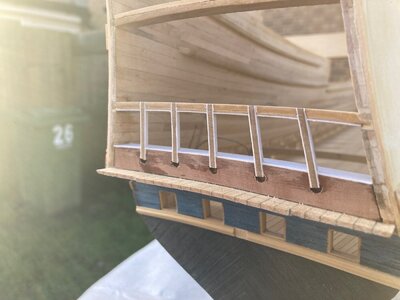
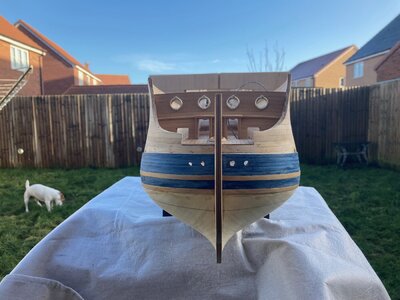
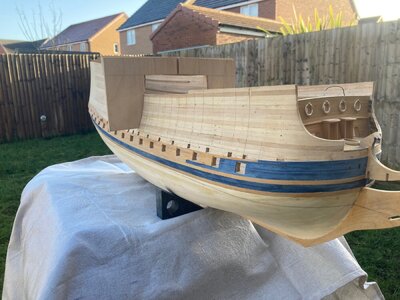
I have fitted the mullions for the stern lights in the lower cabin. These are 2mm square walnut ( in stash) covered with the white veneer. I really want to fit the panelling to the insides of the hull before I add the glazing. I am paused on this while I mull over what I feel is the best way to do this.
I have completed the lower wale and planking on the starboard side to match the Port and am now working on the bow area. I have also sanded the taper on the stem.
Merry Xmas to you all.
Nigel




Fabulous work, Nigel. I really like the use of the white veneer in the cabins. I take it you are using JCL’s SP as your guide, there.
To what degree do you think you might partition the interior, along these lines?


It would require some scale extrapolation of the period French pied to come up with a layout, but it’s doable. To what degree it may be desirable is another question.
One could go nuts with a full doll-house interior and the famous coffered ceiling in the great cabin:
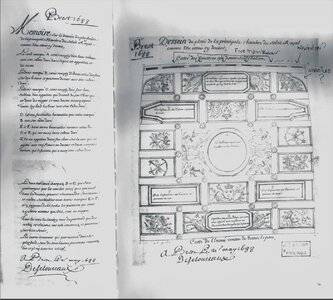
But, I suppose the priority would lay with what could reasonably be seen from above, and through the exposed deck framing.
To what degree do you think you might partition the interior, along these lines?


It would require some scale extrapolation of the period French pied to come up with a layout, but it’s doable. To what degree it may be desirable is another question.
One could go nuts with a full doll-house interior and the famous coffered ceiling in the great cabin:

But, I suppose the priority would lay with what could reasonably be seen from above, and through the exposed deck framing.
Now that I think about it, it might be fun to represent the framing of the coffered ceiling just to show that it’s there. But, that may be a rabbit hole too far.
Last edited:
Thanks Marc. I have looked at these drawings many times before to try and understand what is going on.It may be a stupid question, but which drawing is relevant to which deck?
The decks in the cabins will be fully planked, the interiors will only be visible through the stern lights.
Kind Regards
Nigel
The decks in the cabins will be fully planked, the interiors will only be visible through the stern lights.
Kind Regards
Nigel
My understanding is that the Grand Chamber, with the coffered ceiling, is in the middle deck level. The Captain’s chamber is on the main deck level. Interestingly, Tanneron chose to show the visible bulkheads of this level on the quarter deck level. The Admiral’s chamber would be on the quarter deck level. Housed above him, on the poop deck are a series of small berths for lesser officers.
Interestingly, Michel does not show a visible bulkhead at the QD level:

Also interesting is that the forward bulkhead structures are the same for the grand chamber and the Admiral’s chamber.
Interestingly, Michel does not show a visible bulkhead at the QD level:

Also interesting is that the forward bulkhead structures are the same for the grand chamber and the Admiral’s chamber.
Thankyou, even without scaling things and drawing it out, the cannons of the aftermost ports certainly on the main deck and quarterdeck fall inside the cabins.
The forward most partition of the Grand Chamber has a distinct resemblance to the Tanneron model which he chose to represent on the Quarterdeck.
The forward most partition of the Grand Chamber has a distinct resemblance to the Tanneron model which he chose to represent on the Quarterdeck.
Your blue and now also white veneer is looking great Nigel.
A coffered ceiling would be nice . Nothing is a rabbit hole too far for you
. Nothing is a rabbit hole too far for you , our expectation levels are rising.
, our expectation levels are rising.
BTW thanks for you advice for manufacturing the gratings, to fair the top face to the combing when placed in the model. Result could not be better.
Merry Christmas and Happy Holidays.
A coffered ceiling would be nice
BTW thanks for you advice for manufacturing the gratings, to fair the top face to the combing when placed in the model. Result could not be better.
Merry Christmas and Happy Holidays.
- Joined
- Oct 25, 2022
- Messages
- 294
- Points
- 128

Aren't some of those rooms from the pre refit soleil royal?Fabulous work, Nigel. I really like the use of the white veneer in the cabins. I take it you are using JCL’s SP as your guide, there.
To what degree do you think you might partition the interior, along these lines?
View attachment 347265View attachment 347266
It would require some scale extrapolation of the period French pied to come up with a layout, but it’s doable. To what degree it may be desirable is another question.
One could go nuts with a full doll-house interior and the famous coffered ceiling in the great cabin:
View attachment 347270
But, I suppose the priority would lay with what could reasonably be seen from above, and through the exposed deck framing.
Survey and dismantling began in 1685. The drawings are dated to 1688. The coffered ceiling drawing is definitely an example of “as it was.” The other drawings give me pause because of the number of stern windows represented. If anything, there would likely have been more than 6 window/door openings on the original SR. La Reyne, in 1672, shows 8 windows between the quarters. Given that this was also a Hubac First-Rate completed one year before SR, I think it is reasonable to extrapolate a little bit here. Perhaps the bulkhead arrangement didn’t change, even if it was re-constructed. However, the window arrangement would have changed to conform to Berain’s re-working of Puget’s design.
- Joined
- Oct 25, 2022
- Messages
- 294
- Points
- 128

Guy M in his document says some of them were done before the refit tho. I agree on the original SR having more windows than 5, it was the same for the roya louis. I noticed michel saulnier did something verry different of tanneron for the decks and walls.


Merry Christmas to all!
Besides eating far too much yesterday, I have made a start on the planking below the Wales.The splicing of the two timbers around the waterline is slow going.The thing to remember is not to cut the black planking square to the hull but level to the waterline.This will result in the joint of colours being spliced on a bevel, particularly around the stern area.
Kind Regards
Nigel
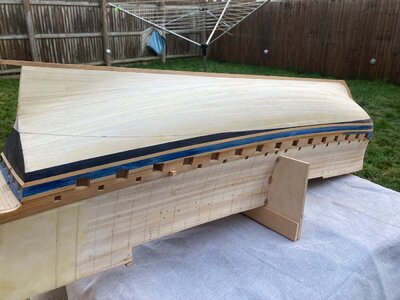
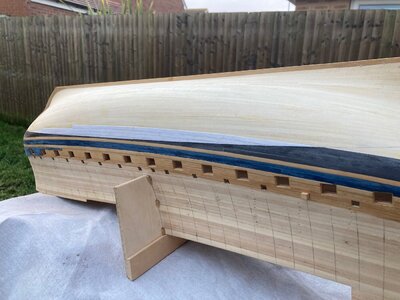
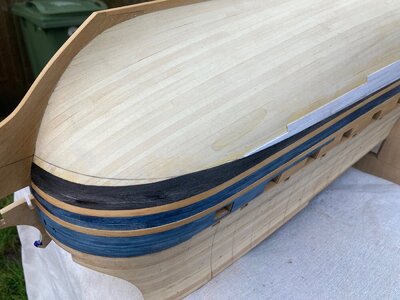
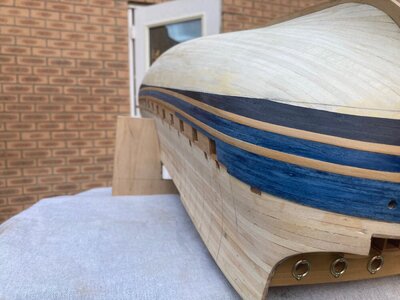
Kind Regards
Nigel




That’s a pretty amazing bit of progress! Pretty fortunate, it seems, that most of the tricky spiling happens below the waterline. How you managed that thread of planking with a perfect cut line, along the waist, I would love to know.
Last edited:




